One of the most intense one-on-one sports in the world, racquetball is a fast, frenetic bout of competitive cardio, loved by people of all ages across the planet.
But it’s not all about huffing and puffing around the court and its corners. The best players know that while racquetball is often about power play, it’s also a delicate game of finesse and flair, so a good player is only as good as the racquet they use.
A good racquetball racquet allows for both gentle and explosive shots along with the ability to play technically and tactically. Without a good racquet, it’s hard to play with the subtlety and technique which a good game requires.
A good racquetball racquet should also be comfortable, durable and lightweight, so your hands don’t end up raw and ragged after a few hard games.
For more finesse, power and accuracy a good racquet is essential. So we’re here with a list of recommendations for the best racquetball racquets. With a racquet from this list, you’ll be able to casually smash your opponents off the court – and into a quivering wreck of tears.
Contents
- What to Consider When Choosing a Racquet
- Top 10 Best Racquetball Racquets 2024
- 1. Best Overall Racquet: Wilson Striker
- 2. Best Mid-Range Racquet: Head Intelligence i.165
- 3. Best Balanced Racquet: Head Liquid Metal
- 4. Best Racquet For Advanced Players: E-Force Bedlam
- 5. Best Large-Grip Racquet: E-Force Chaos
- 6. Best Premium Racquet: Head Black Widow
- 7. Most Versatile Racquet: Head Ares Series
- 8. Best Budget Racquet: Head MX Fire
- 9. Best Racquet For Beginners: Python Intro 500
- 10. Ektelon Toron Racquetball Racquet
- Everything You Need to Know Before You Buy a Racquetball Racquet
- Determining Your Racquet Grip Size
- How Does a Racquetball Racquet Differ From a Tennis Racket?
- What About Squash? Is That the Same as Racquetball?
- Can My Kids Play Racquetball?
- Racquetball Can Be a Little Dangerous. Are There Any Protective Measures I Should Take?
- How Can I Prevent My Racquetball Racquets Strings From Breaking?
- Price
- Weight
- Grip
- Final Thoughts
What to Consider When Choosing a Racquet
When choosing between the best racquetball racquets, here are the main things you need to consider:
- Weight: broadly speaking, lighter is better. You don’t want to be swinging a heavy racquet around for hours and hours. A lightweight racquet helps you to play for longer without your arms getting tired. That said, if you like to hit heavy and hard, you don’t want to buy a racquet which is too light.
- Balance: different racquets are weighted in different ways. If a racquet is head-weighted, it’s built to generate more power. If a racquet is head-light, it’s better for players who play with flair and finesse. Some have an even balance for well-rounded players. Think about the type of player you are (and the type of player you want to be), before you invest in a racquet.
- Grip size: different people have different grip sizes. Choose a grip size which is appropriate for you. Later in this guide, we’ve included information on how to measure your grip size .
- Head size: a bigger head size allows for heavier hits – and offers a little more room for error.
- Comfort: you want your racquet to feel good in your hand and on the court. If it doesn’t, you won’t have a good time. No-one plays racquetball to have a bad time… but if you buy the right racquet, the only people having a bad time will be your opponents.
Some companies offer gender-based racquets. This is a marketing ploy. Don’t fall for it. Apart from color choices or a meaningless name, there’s no such thing as racquets for women or racquets for men. They’re all the same. It doesn’t matter what color your racquet is. What does matter is the features we’ve listed above!
Below, we’ve listed ten of the best racquetball racquets. We’ve evaluated and assessed each in four categories: grip and head size, weight, performance and comfort. No matter your playing style, your budget or your ability level, we’ve got the perfect racquetball racquet for you.
Top 10 Best Racquetball Racquets 2024
1. Best Overall Racquet: Wilson Striker
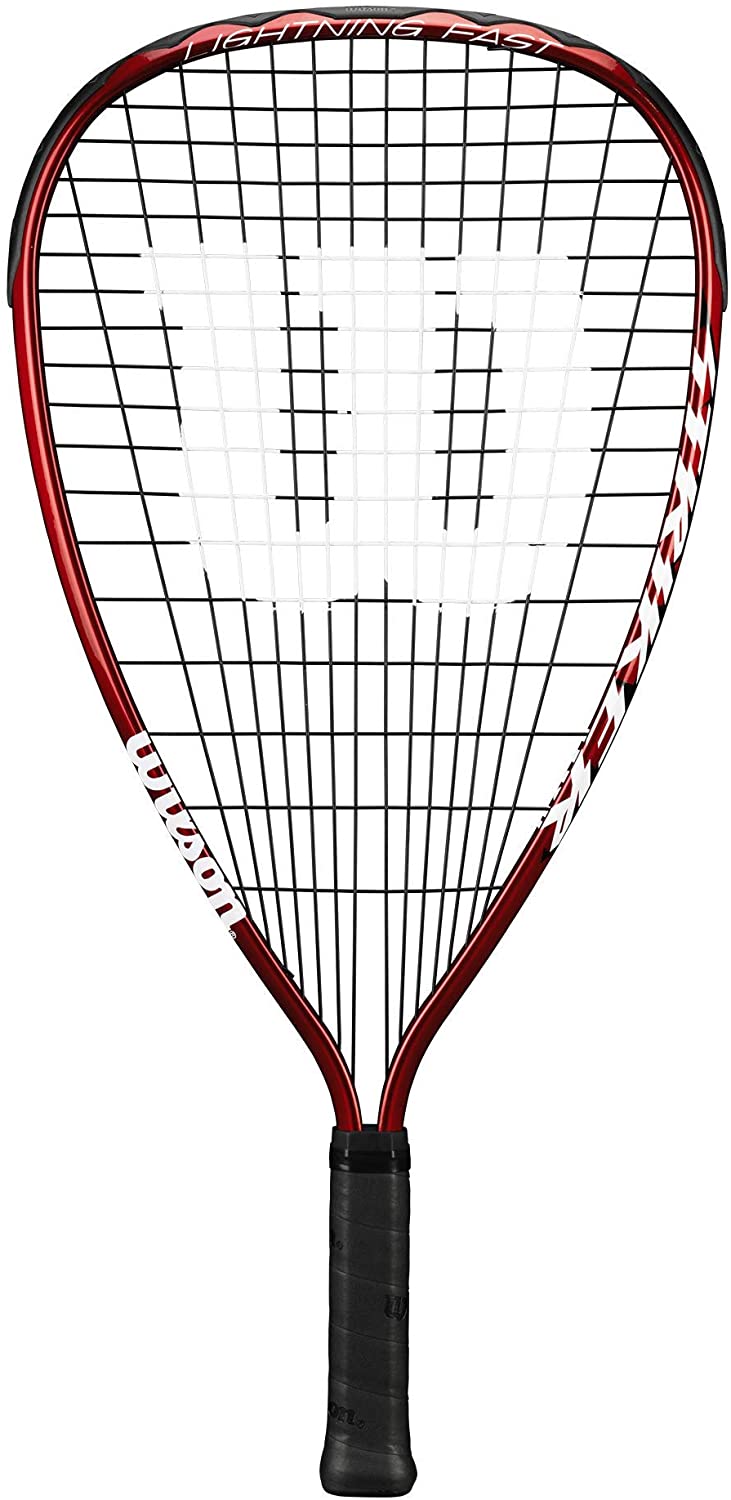
Editor’s Rating:
Grip/Head size
Grip size: 3 ⅝”
Head size: 107 sq. inches
Weight
At over 7 oz, this isn’t the lightest on the market, so it’s not great if you want a racquet built for finesse. Instead, it’s designed to generate power. And it does the job excellently. The V-Matrix frame of the racquet adds a little weight, but it’s great for delivering heavy, hard shots.
Performance
The wiring allows for a rough, rugged shot style, and it’s weighted in a way to promote aggressive over nuance. The aluminum alloy build keeps the racquet strong and sturdy, so it won’t falter under aggressive play – and it should last you a long while. The V-Matrix cross-section of the frame offers added stiffness and strength. If you’re a beginner or intermediate, or if you love playing with power, you’ll love this racquet.
Comfort
It feels great, especially for a racquet at this price point. If this is your first foray into good racquetball racquets, you’ll be surprised at how light it feels in the hand, and how comfortable it is. The racquet comes with a strap. With a firm grip, this is great for battling sweaty hands.
- If you want a good basic racquet, this is it
- Great for power players
- Performs way better than other racquets in the same price range
- Great price point
- Lots of added features help you to add aggression to your game
- Experienced players won’t find this light or sophisticated enough
2. Best Mid-Range Racquet: Head Intelligence i.165

Editor’s Rating:
Grip/Head size
Grip size: 3 ⅝”
Head size: 103 sq. inches
Weight
At 5.8 oz, this is incredibly lightweight, allowing for plenty of nuance and hours of play. If you want a mid-range but lightweight racquet, builds really don’t get any better than this. While it’s light, it’s still pretty robust. The string fibers are built specifically to stiffen on impact to offer more zip and pace to your shots.
Performance
Though lightweight, the build is head-heavy, which allows for lots of power along with excellent accuracy and placement. The performance here is great for all-round players who like to combine flair with aggression. The shape of the head can make the racquet feel quite small when you’re holding it. Some players will like this, some players won’t.
Shots with this racquet feel stiff and solid, so it’s easy to generate power. That said, the stiffness can make very delicate shots a little difficult – they can bounce off the racquet rather than providing the glide that more gentle players may need.
The titanium and graphite build makes for a racquet which is very durable. This can definitely withstand a few whacks off the wall (accidental or otherwise).
Comfort
Because it’s lightweight, this isn’t taxing on the arms at all. The grip also feels really great.
- Very lightweight without sacrificing power
- The tight strings make a power game easy
- Very durable
- Nice head-heavy build
- Comfortable
- Players who love delicate shots might find this a little too robust
3. Best Balanced Racquet: Head Liquid Metal
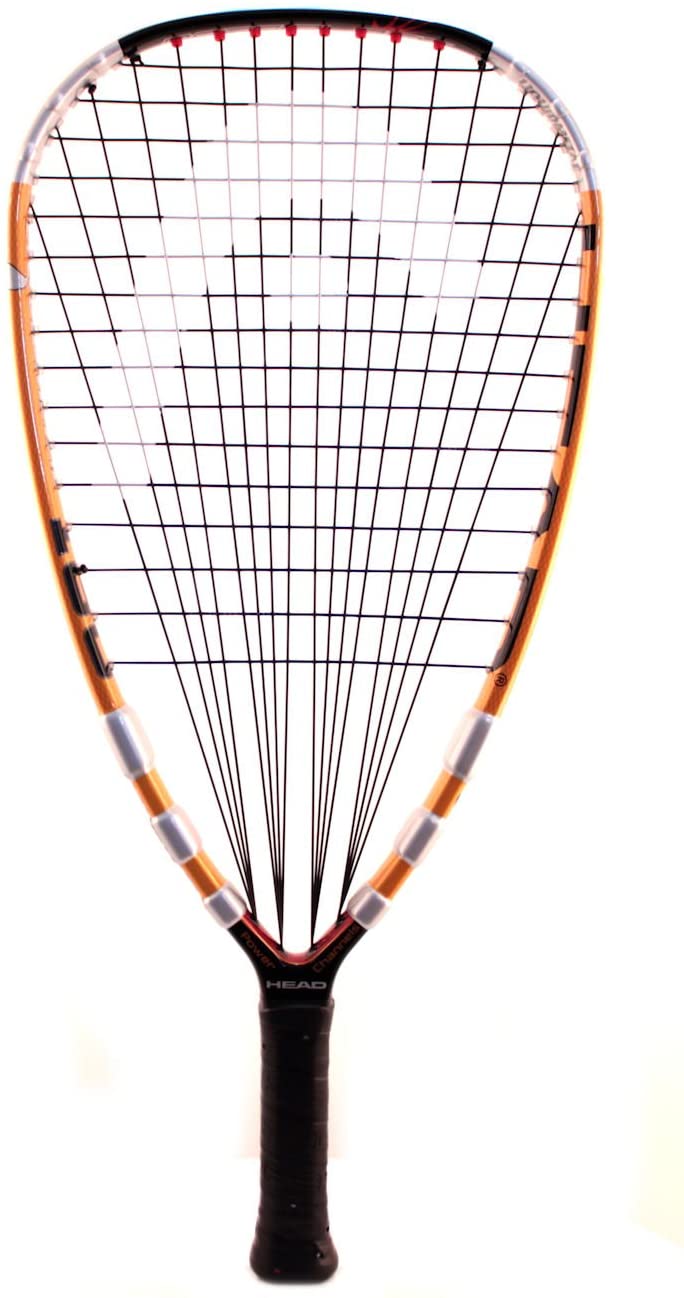
Editor’s Rating:
Grip/Head size
Grip size: 3 ⅝”
Head size: 106 sq. inches
Weight
All of the sizes are lightweight, but the smallest weighs in at only 6oz, which is fantastic. 6oz sits right between what is categorized as lightweight and medium weight, making it a good choice for lots of players. Though lightweight, this racquet is a little head-heavy, so it still generates a good amount of power—though maybe not enough for pure power chasers.
Performance
If you want a balanced performance, this is absolutely brilliant. Though very slightly head heavy, there aren’t many racquets which offer delicate shots and powerful shots in equal measure. But this is absolutely one of them.
The strings are stiff without being ultra-tough, so you have lots of control over all of your shots. It’s not strung so tightly that soft shots will ping uncontrollably around the court.
The liquid metal build is designed to provide integrity and strong structure, so the racquet doesn’t crumble under the pressure of very aggressive shots. It’s built to handle pressure across the whole surface of the racquet, so a slightly-misplaced shot won’t push you out of position. It absorbs shock very well.
Comfort
Fantastic. It feels great in the hand, and the shock absorption makes for a comfortable feel even during the game. It’s built with Hydrosorb technology to fight against sweaty palms. Unless you’re super sweaty, you won’t need grip tape for this one.
- The most well-balanced racquet on the market
- The grip battles sweat very well
- Lightweight
- Incredibly durable
- A little pricey
- Those who love a pure power game might find this a little too weak
4. Best Racquet For Advanced Players: E-Force Bedlam
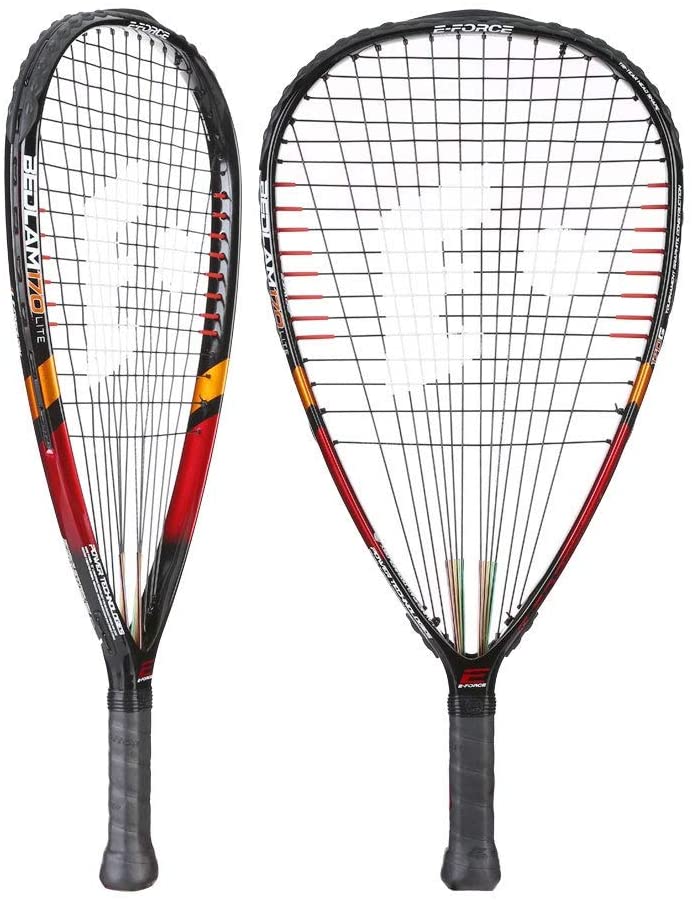
Editor’s Rating:
Grip/Head size
Grip size: 3 ⅝”
Head size: 108 sq. inches
Weight
At 6oz, this is fantastically lightweight. The handling can feel a little stiffer than other lightweight racquets, but if you want lots of control and finesse with a light weight, it doesn’t get much better than this.
Performance
In the hands of an amateur, this is wasted. But in the hands of an expert who knows the intricacies of handling a racquet built for precision, this performs phenomenally. The vibration dampening is excellent, allowing you to perfectly glide from one shot to the next without any aftershock or risk of injury.
There’s also a great deal of control here. You feel like you’re in absolute control of every single shot. The sweet spot on this one is fantastic, and immediately noticeable. If you want a racquet with a sweet spot, this is the best you’re going to find without spending outrageous amounts of money.
Comfort
It can feel a little stiff, but it’s otherwise very comfortable. There’s no aftershock and after you become accustomed to it, this feels very natural in the hand. The only real downside here is the grip. It’s not great against the hand. You might want to invest in some grip tape for this racquet.
- For seasoned veterans looking to add that final part of nuance to their game, this is excellent
- Lightweight
- Excellent sweet spot
- Great accuracy and control
- Fantastic anti-vibration technology
- Feels a little stiff at times
- The grip isn’t great
5. Best Large-Grip Racquet: E-Force Chaos
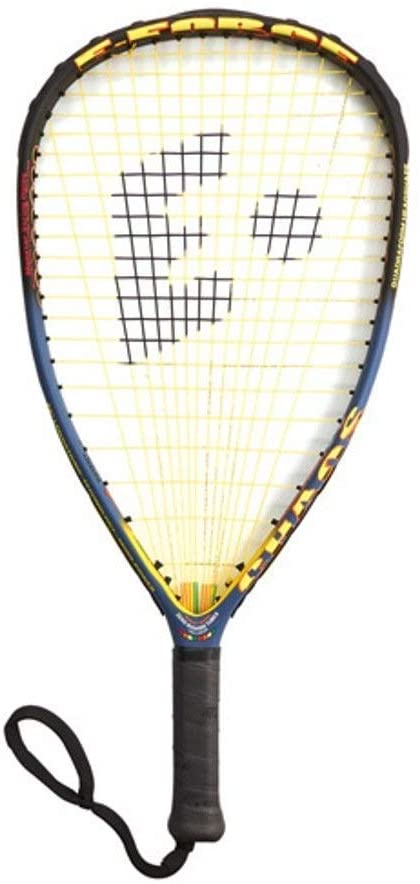
Editor’s Rating:
Grip/Head size
Grip size: 3 15/16”
Head size: 107 sq. inches
Weight
At almost 9 oz, this is a heavy racquet, but it’s built for generating huge amounts of power. And because of that, the weight can be a useful tool for the right player.
Performance
Because this racquet is made for power and big shots, it has a number of features which heavy-hitting players will love. The racquet has fewer strings, which means big holes – which in turn means less air resistance.
The frame’s graphite fibers are also designed to generate more power. Despite its heavy build and focus on powerful performance, this racquet still provides a good amount of finesse and shot control. With this racquet, you don’t have to sacrifice good delicate shots in the pursuit of more power.
Comfort
Some people might find this too heavy, and therefore a little tiring after long periods of play. That said, there’s very little vibration on this and the handle is very comfortable. There’s a small wrist lacer attached to the racquet.
- An excellent choice for players with a larger grip
- Great for power players
- Decent price point
- Though this racquet is built for power, it still delivers good delicate shots
- Some players might find this too heavy
6. Best Premium Racquet: Head Black Widow

Editor’s Rating:
Grip/Head size
Grip size: 3 ⅝”
Head size: 106 sq. inches
Weight
This is where this racquet really excels. Crafted from carbo-polypro materials, it’s very hard to find a lighter racquet which performs this well. If you’re a power player, this might be too light for you. But if you like good response and feel in your rallies, you will love the way this feels and plays.
Performance
As we’ve said, this offers incredible response during rallies. And because of the lightweight build, it’s excellent for gentle shots.
But though it’s lightweight, it’s still very rugged and durable, so you don’t have to worry about breaking the racquet during play. It’s hard to find a racquet which balances lightweight performance with tough durability. But this racquet does just that excellently.
The vibration-dampening is fantastic, which is excellent for preventing injury and distraction – and for having greater control over your shots.
Comfort
Because of the vibration-dampening build, this is extremely comfortable. There’s no aftershock and it’s great for battling fatigue.
The grip is pretty average. It’s not the firmest, but it shouldn’t need tape unless you’re a particularly sweaty person.
- If a lightweight racquet is your priority, this is brilliant
- Very responsive for rallies
- Durable
- Great vibration-dampening
- This might be too expensive for some people
- Not great for maximum power
7. Most Versatile Racquet: Head Ares Series
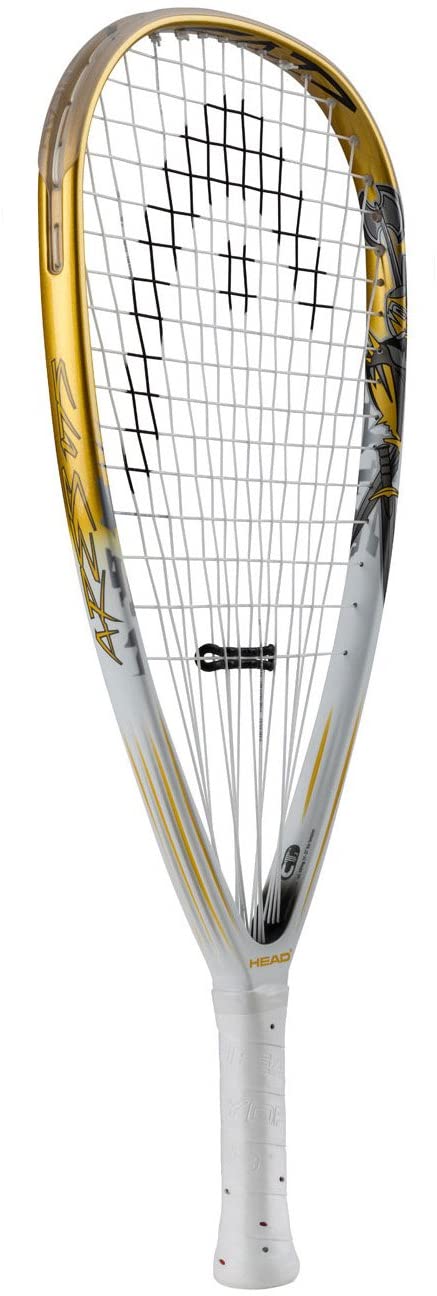
Editor’s Rating:
Grip/Head size
Grip size: Available in both 3 ⅝” and 3 ⅞”
Head size: 107 sq. inches
Weight
All three racquets are lightweight, but the 5.8oz performs particularly well in this category. Head makes excellent lightweight racquets which provide great feel without having to sacrifice too much power.
Performance
The sweet spot on these racquets is big and impressive. This is great for intermediate players who might not have their shot placement exactly down, as it gives some room for error.
All of these racquets are head heavy, so they’re excellent for generating powerful shots. And because of how light they are, it’s very easy to generate lots of power, even from awkward positions. Built with Megablast strings, it’s an excellent example of how a light racquet can churn out heavy shots.
If you want a lightweight racquet which still hits hard, this is an excellent pick. But the durability isn’t great – you might find that this breaks more easily than you’d like.
Comfort
The Hydrosorb grip is very comfortable and is great for combating sweaty hands. The racquet is built intelligently, so it feels light and comfortable when playing.
- With two grip choices and three weight choices, this is great for finding a bespoke racquet
- Great power despite the lightweight build
- A good choice for players who want a balance between delicate and powerful play
- The Hydrosorb grip is great for combating the slippy pitfalls of sweaty palms
- This might be a little too expensive for some players
- The durability is poor
8. Best Budget Racquet: Head MX Fire
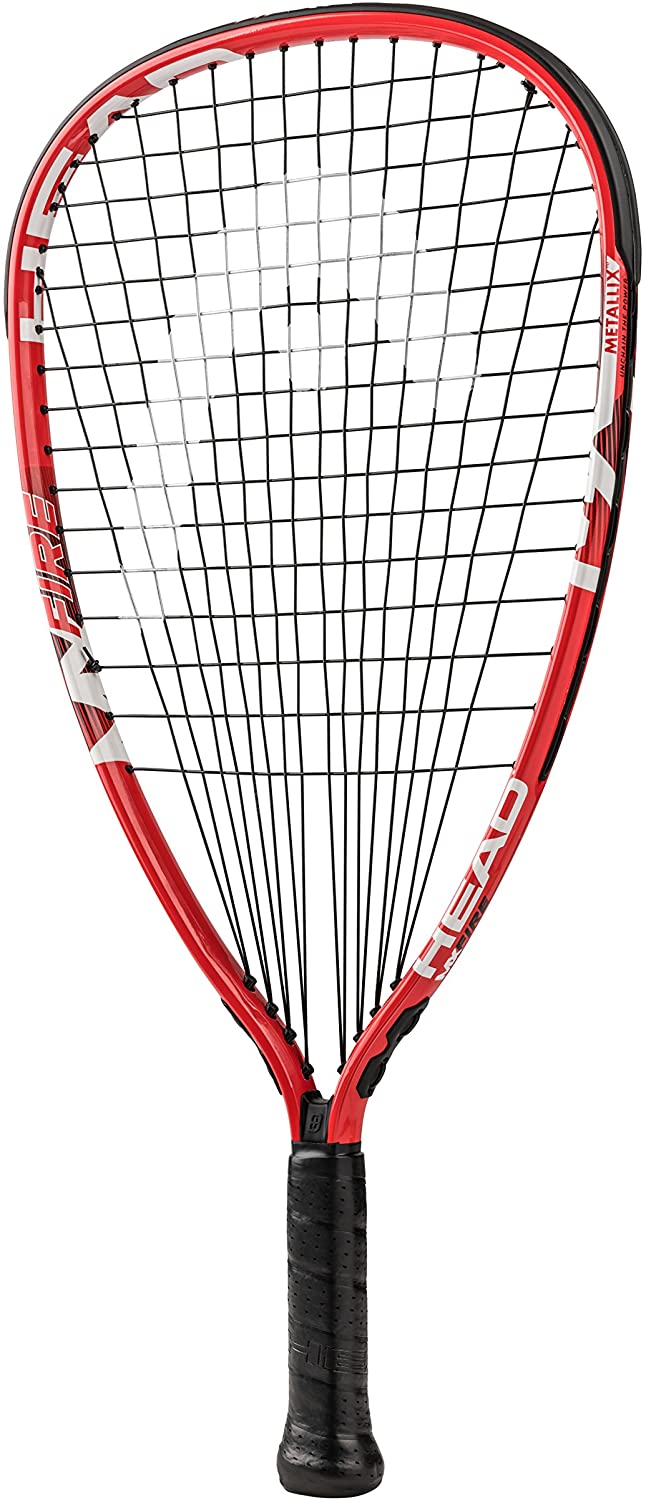
Editor’s Rating:
Grip/Head size
Grip size: 3 ⅝”
Head size: 107 sq. inches
Weight
At 6.7 oz, it’s a little heavier than some others we’ve listed. But because this racquet is built for beginners, this is actually useful. Beginners will love this racquet – it’s lighter than basic racquets, but heavy enough for inexperienced players to feel like they still have enough control.
If you’ve never before invested in a good racquetball racquet, this is an excellent first purchase – and at a very good price.
Performance
With a strong, stiff frame and a decent amount of weight, this is great for generating power. This build also gives lots of stability and control. In the hands of an amateur, a more advanced racquet may not feel controlled or steady enough. But this offers a great all-round performance with enough control.
Unusual in budget racquets, the shape of the racquet is designed to reduce vibration. The only real flaw here is durability. This might break after a while. But because of the price point, that isn’t really too much of a problem.
Comfort
If this is your first good racquet, you’ll find this very comfortable. It reduces vibration, feels good in the hand and feels fairly light. The wrap around the handle isn’t the most durable, so you might want to buy some grip tape for this racquet.
- If you want a great racquet at a low price, this is our best pick
- Delivers good all-round performance
- Strong, stiff and fairly heavy, this generates great power
- Will be too heavy and too basic for advanced players
- The durability isn’t great
9. Best Racquet For Beginners: Python Intro 500
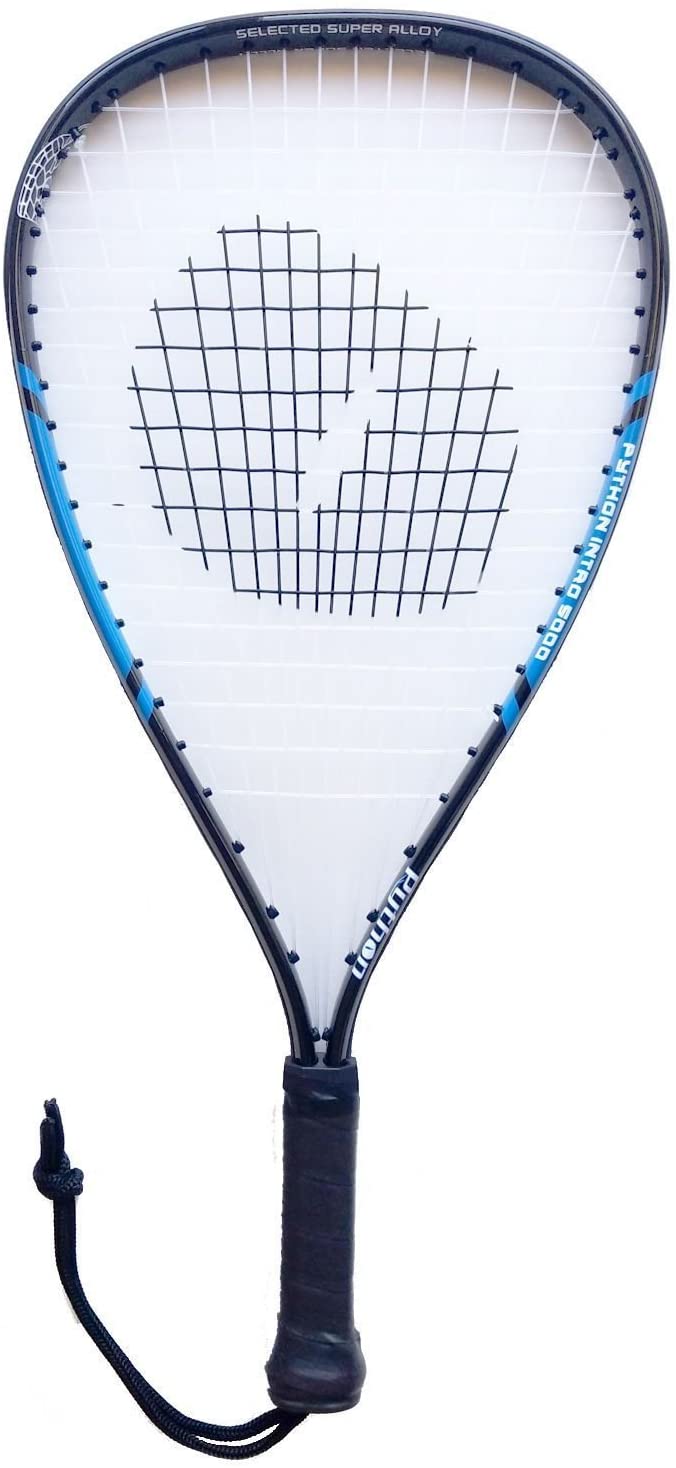
Editor’s Rating:
Grip/Head size
Grip size: 3 ⅝”
Head size: Not specified
Weight
At 8 oz, this is heavy. But that’s perfect for beginners—when you’re just getting started, size, grip, and comfort are far more important than a slight reduction in weight. And while it’s heavy for a quality racquet, it’s likely still lighter than any other racquet a beginner will have used before. It provides a lightweight enough build while still providing sufficient control and support. In the hands of a real beginner, an overly light racquet is wasted.
Performance
This racquet has a firm grip, an aluminum build and a V-shaped design. All of these features are provided to offer a racquet with great power. If this is your first good racquet, you’ll be surprised by just how much power you can generate.
The sweet spot is pretty small and you won’t get the super delicate shots offered by other racquets on this list, such as the E-Force Bedlam . But for a beginner, this is as good as it gets.
The racquet also has a small wrist lacer, though this might be a little small for some people.
If you have a kid who’s interested in racquetball, this is a good choice – it’s perfect for beginners but it’s also heavy, robust and basic enough that they’ll find it easy to use. It’s also very durable, so it shouldn’t get broken when beginners inadvertently smash it off a wall.
Comfort
The grip is great and it’s really good at combating sweaty palms. Though it’s a heavy racquet, it doesn’t feel cumbersome.
- This is a great basic but effective racquet for beginners
- The grip is strong and sturdy
- Generates excellent power, especially for a beginners’ racquet
- Good price point
- Very durable
- This isn’t suited to anyone other than beginners
- The wrist strap is a little small
- Lacks a little finesse
10. Ektelon Toron Racquetball Racquet
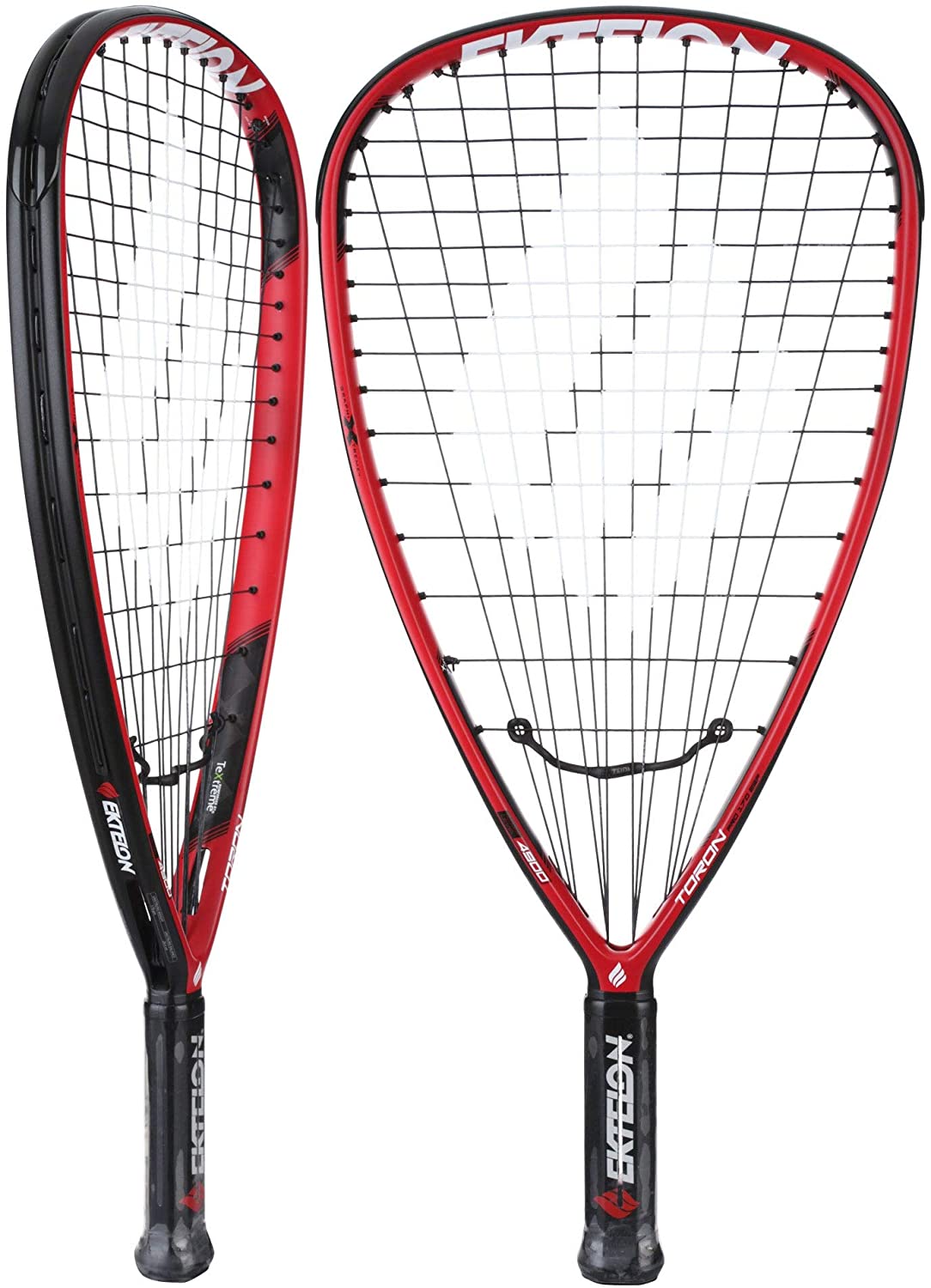
Editor’s Rating:
Grip/Head size
Grip size: Comes in two sizes – 3 ⅝” and 3 ⅞”. The 3 ⅝” version even comes with a “round” option which offers a rounder grip size.
Head size: 106 sq. inches
Weight
There are 3 weight options here – 5.6oz, 6oz and 6.3oz. All of these options are very light – but because of the intelligent, expensive, well-weighted design, they all feel even lighter in play.
Performance
The teardrop shape makes for a great sweet spot, good power and excellent delicate shots, while the graphite frame offers easy swinging. While most racquets focus on either power or finesse, this offers a good compromise between the two, making it an excellent choice for an all-rounder.
The grip is fantastic, which really helps you to get behind your shots – and helps with accuracy and aim. The durability isn’t great considering the high price point. If the durability was better, this would be a much better racquet.
Comfort
The grip is excellent, so you won’t need grip tape, even if you have the world’s sweatiest hands. The vibratio -protection isn’t quite as good as some others on this list, but it’s still pretty effective.
- Great sweet spot
- An excellent compromise between powerful play and gentle play
- Excellent grip on the handle
- Lots of different size and weight options
- Pricey
- Not very durable
- Doesn’t offer the best protection against vibration
Everything You Need to Know Before You Buy a Racquetball Racquet
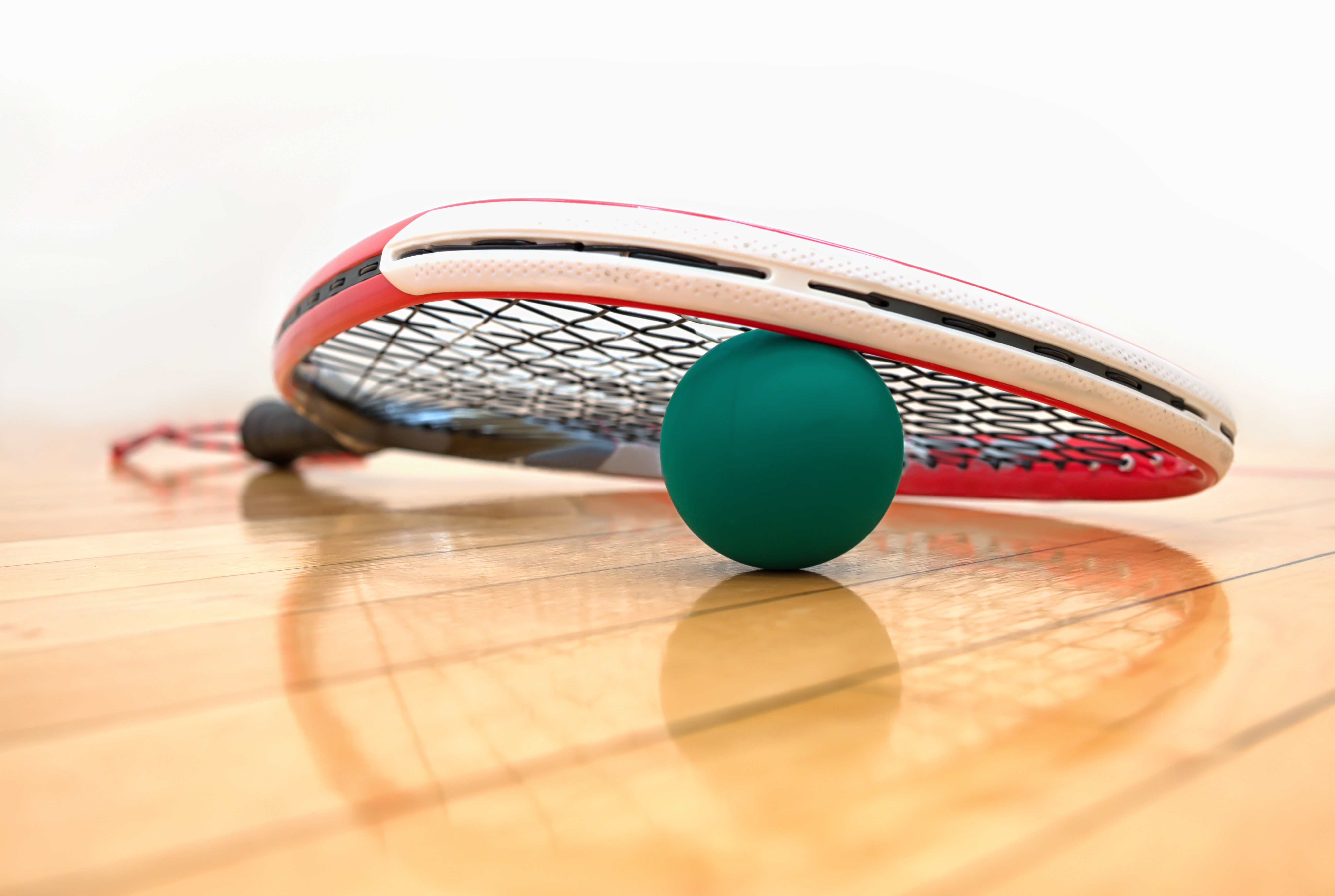
There you have it – the top 10 best racquetball racquets! They’re all perfect for destroying your opponent on the court, and improving your own game in the process.
But there are many things to consider before you invest in the perfect racquet. Though all the ones we’ve included are excellent options, it’s important to pick a racquet that works specifically for you. In this section of our guide, we’ve unpacked everything you need to know before making your purchase.
Determining Your Racquet Grip Size
Grip sizes only vary slightly. But they make a huge amount of difference. Everyone’s hands are a different size, so everyone’s grip is a different size.
Here’s how to measure your grip size:
Turn your palm up and extend your fingers. Using a tape measure, measure from the end of your ring finger to the bottom lateral crease in the middle of your palm. That’s your grip size. You can also check if you’re using the right grip size by testing your existing racquet (if you have one!).
If you want to add grip tape to your racquet, make sure you buy a size smaller than you should. Once you add a layer of grip tape, the diameter of your handle will of course be bigger than it was before.
How Does a Racquetball Racquet Differ From a Tennis Racket?
Don’t use a tennis racquet for racquetball!
Tennis racquets and racquetball racquets are very different. Here’s why:
- Tennis racquets have longer shafts, for generating more power.
- Tennis racquets have a rounder head shape, whereas racquetball racquets are generally a little more square.
- Racquetball racquets have less symmetrical strings than tennis racquets, which helps with delicate, nuanced shots.
- Racquetball racquets are sturdier and stronger, which helps them to withstand impact. Racquetball racquets are more likely to hit walls, floors and even other players.
Lots of people think you can use a tennis racquet for racquetball. That’s why they’re terrible at racquetball.
If you are in the market for a tennis racquet, though, check out our list of the best tennis racquet—just don’t use them to play racquetball.
What About Squash? Is That the Same as Racquetball?
Squash and racquetball are similar but they’re not quite the same. The court sizes are different and squash has an out of bounds area. But much more importantly than that, squash balls and racquets are very different to their racquetball counterparts. So don’t buy a squash racquet for racquetball!
Here’s a more in-depth guide to the differences for those who are particularly interested.
Can My Kids Play Racquetball?
Absolutely! It’s rare that kids play racquetball because it’s pretty intense. It’s pretty unusual and it’s often thought of as a game for older people – whatever that means. But there’s no real reason kids can’t play the game.
Because there are very few youth-specific pieces of racquetball equipment, lots of adults think that racquetball isn’t for kids. But it definitely can be. Just make sure your kids are using the right equipment – and that they know how to stay safe on the court.
But most importantly, don’t look for a youth’s racquetball racquet. No such thing exists. Or at least no good one does. What you should instead do is buy a good-quality beginner’s racquet instead, such as the Python Intro 500 .
Racquetball Can Be a Little Dangerous. Are There Any Protective Measures I Should Take?
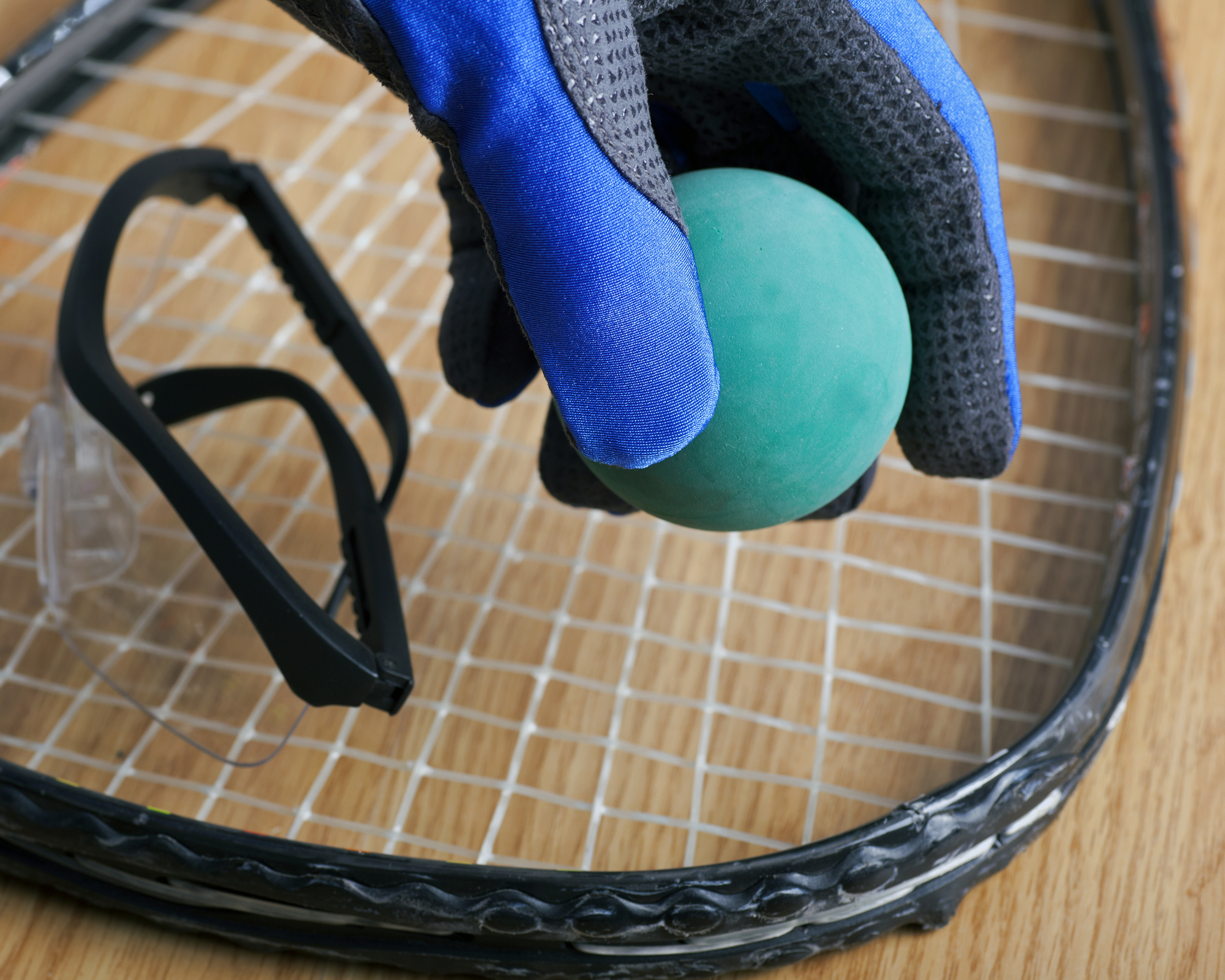
Absolutely. A good arsenal of equipment doesn’t begin and end with a good racquet. There are lots of other things you should invest in. Most of these will make your game safer. Lots of them will make your game better. Here are some other pieces of racquetball gear you should consider buying.
Knee pads: if you play a lot, you’ll know how much of a game you can spend on your knees. Diving to get down to an important shot can leave you with scrapes and scratches on your knees. If you’ve never before experienced a bad scrape, you will soon. So invest in some good racquetball knee pads before that happens.
Goggles: eye injuries and even sight loss are associated with racquetball. And if you can’t see, you won’t be a very good player. So get some good eye protection.
Grip tape: sweaty hands make for sweaty racquets. Grip tape allows you to (you’ve guessed it!) grip your racquet better, even with the slippiest and sweatiest of palms. Though this isn’t necessary for all players, sweaty people should invest in good grip tape – especially if your racquet doesn’t offer the best grip. Some people even use specialized racquetball gloves.
Shoes: normal sneakers are often good enough. But if you’re a serious player, you want serious shoes. Without them, your better-equipped opponents will always have an edge over you. With shoes, it’s important to buy something that works for you and your feet. For example, you should consider how supportive you want the shoes to be, how breathable you want them to be, and whether you’re male or female.
Sweatbands: wiping sweat out of your eyes is annoying and distracting. If you’re always the unwilling victim of a sweaty head, good sweatbands will keep you from having to wipe your face. Something basic is often enough.
How Can I Prevent My Racquetball Racquets Strings From Breaking?
Sometimes, that’s an inevitability, but there are some things you can do to reduce the chances of your strings breaking. The first one is to buy a good racquet. All of the ones on this list fit the bill. If you buy a poor racquet, you’ll get poor strings.
Aside from buying a good racquet, here are some other things you should be doing:
- Get your strings tightened regularly. More play means more wear on your strings. And more wear means looser strings. The looser your strings, the more chance of them snapping.
- Get the whole racquet restrung. If you love your racquet but it’s no longer performing the way it used to, a re-string can get it back to where it once was – and prevent it from snapping.
- During breaks in play, rearrange your strings to their original position. During play, they can go out of shape. Being out of shape can make the strings more likely to break.
Price
Racquetball racquets massively range in terms of price. Like with anything, you get what you pay for. So if you’re an expert player who needs something incredible, don’t buy a $25 racquet. That said, a $25 racquet can feel excellent in the hands of a beginner.
Beginners can get their hands on a decent racquet for around $25 or so, while a seasoned veteran might expect to pay up to $150 or $200. Think about the level you’re at and buy accordingly. While a cheap racquet won’t benefit a good player, a very expensive technical racquet will be wasted on a beginner.
Weight
Though we’ve already discussed racquet weight, here’s a little more depth on the matter. Broadly speaking, racquets fall into the category of light, medium or heavy, which makes for a surprisingly convenient way to measure weight. Here’s how the categories work:
- Light racquets are around 6 oz or under.
- Heavy racquets are around 7 oz of over.
- Medium racquets are – you’ve guessed it! – somewhere in the middle.
For beginners, heavier is usually a little better. Heavier racquets generate a little more power than lighter racquets, but they can weigh you down and make you feel fatigued during a long game. Lighter racquets are easier on the arm and offer a little more nuance and technique.
Though nobody wants a super-heavy racquet, the weight you choose is in some ways correlated to the type of player you are, and the type of player you want to be. If you’re a beginner, don’t go too light.
Grip
We’ve briefly mentioned grip above. But some racquets are built with grippier materials than others. If you are prone to sweating and don’t want to use grip tape, you should buy a racquet which is built for combating sweaty hands and fingers. A good pick is the Head Ares Series .
Final Thoughts
Racquetball is great. It’s fun, it’s exciting and it’s incredible exercise. But playing with a poor racquet can suck much of the enjoyment out of the game. It can also massively inhibit your ability to play well. If you’re running around the court with a shoddy racquet in your hand, you’re not going to perform.
For this reason, it’s essential to invest in a great racquet. Any of the racquets in this list will hugely improve your racquetball performance. In this list, we’ve included ten of the best. For smashing your opponent off the court and improving your game immeasurably, pick one from this list. You’ll be playing better than you ever have before, and leaving your opponents quivering fearfully in your imposing wake.
Buy a racquet from this list, get yourself on the court and shoot yourself to victory!
